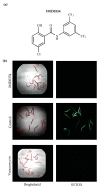New Antimicrobial Bioactivity against Multidrug-Resistant Gram-Positive Bacteria of Kinase Inhibitor IMD0354
- PMID: 33019726
- PMCID: PMC7601562
- DOI: 10.3390/antibiotics9100665
New Antimicrobial Bioactivity against Multidrug-Resistant Gram-Positive Bacteria of Kinase Inhibitor IMD0354
Abstract
Multidrug-resistant pathogens pose a serious threat to human health. For decades, the antibiotic vancomycin has been a potent option when treating Gram-positive multidrug-resistant infections. Nonetheless, in recent decades, we have begun to see an increase in vancomycin-resistant bacteria. Here, we show that the nuclear factor-kappa B (NF-κB) inhibitor N-[3,5-Bis(trifluoromethyl)phenyl]-5-chloro-2-hydroxybenzamide (IMD0354) was identified as a positive hit through a Caenorhabditis elegans-methicillin-resistant Staphylococcus aureus (MRSA) infection screen. IMD0354 was a potent bacteriostatic drug capable of working at a minimal inhibitory concentration (MIC) as low as 0.06 µg/mL against various vancomycin-resistant strains. Interestingly, IMD0354 showed no hemolytic activity at concentrations as high as 16 µg/mL and is minimally toxic to C. elegans in vivo with 90% survival up to 64 µg/mL. In addition, we demonstrated that IMD0354's mechanism of action at high concentrations is membrane permeabilization. Lastly, we found that IMD0354 is able to inhibit vancomycin-resistant Staphylococcus aureus (VRSA) initial cell attachment and biofilm formation at sub-MIC levels and above. Our work highlights that the NF-κB inhibitor IMD0354 has promising potential as a lead compound and an antimicrobial therapeutic candidate capable of combating multidrug-resistant bacteria.
Keywords: IMD0354; high-throughput screening; vancomycin-resistant Staphylococcus aureus; vancomycin-resistant enterococci.
Conflict of interest statement
The authors declare no conflict of interest.
Figures







References
Grants and funding
LinkOut - more resources
Full Text Sources
Molecular Biology Databases
Miscellaneous

